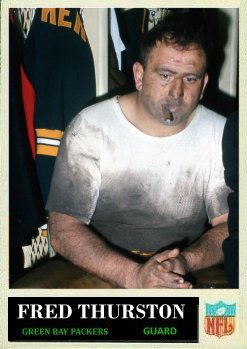

The 1941 season concluded on Pearl Harbor Sunday, the last NFL season before World War II. The Packers had completed their schedule with a 10-1 record on November 30, so the entire Packer team travelled to Chicago on December 7 to scout the 9-1 Bears in their season finale against the crosstown Cardinals. The Bears prevailed 34-24 to set up a playoff match on December 14 at Wrigley Field between two teams that had only lost to each other.
Although Green Bay was second in the league in scoring and points allowed, the one-sided playoff game demonstrated that the 30-point-a-game Bear T formation was a machine that rolled over everything in its path. Green Bay had eked out a 16-14 win over Chicago at the beginning of November when Curly Lambeau installed a seven-man line, but that was an aberration. In the playoff, the Packers took an early lead of 7-0 after recovering a fumble on the opening kickoff at the Chicago 18 and driving in for the score. However, the Bears scored the next 30 points in the game, including 24 in the second quarter, to turn the match into a rout.
For the regular season, the Packers were 5-1 at home and 5-0 on the road. They were 7-0 against teams with losing records and 3-2 against those with winning ones. Veteran star Arnie Herber was cut before the season, so Cecil Isbell took full charge of the offense. Isbell led the NFL in pass attempts, completions, yards (1,479) and touchdowns (15). Hal Van Every was second in passing yards for the Pack with 195.
Clarke Hinkle led the team in rushing yards with 393 and was trailed by Isbell’s 317 and Andy Uram’s 258. Uram also had a punt return touchdown of 90 yards. Don Hutson led the NFL in catches (58), receiving yards (738) and TD receptions (10). Lou Brock, a halfback that Lambeau liked to split wide as a flanker, was second on the squad with 22 receptions. All the ends aside from Hutson combined for just 20 catches.
Hutson also led the league with 95 points scored. Hinkle was second on the team with 56 points. Van Every led the team with three interceptions. Hurson also won the Joe Carr Trophy as the NFL’s most valuable player for ’41.
Isbell, Hutson, Hinkle and tackle Baby Ray were all named All-Pro, with center George Svendsen, guard Pete Tinsley and end Ray Riddick receiving second team notice. Tony Canadeo and George Paskvan were the top rookies.












All custom cards are colorized.



















































































 Packers unveil new “Safety First” defensive scheme.
Packers unveil new “Safety First” defensive scheme. Herb Adderley penalized for Social Distancing violation.
Herb Adderley penalized for Social Distancing violation. Henry Jordan flagged for grabbing the face mask.
Henry Jordan flagged for grabbing the face mask. Fuzzy Thurston ejected for not washing hands.
Fuzzy Thurston ejected for not washing hands. Offsetting penalties for illegal large gathering.
Offsetting penalties for illegal large gathering.